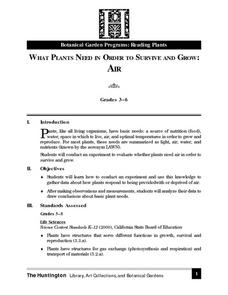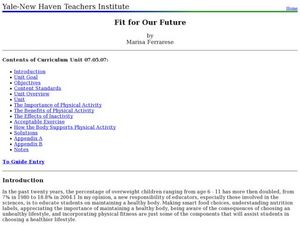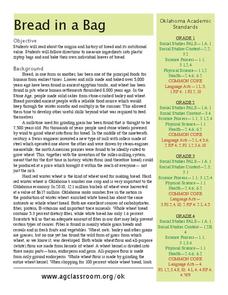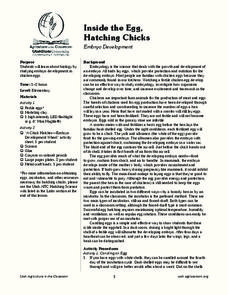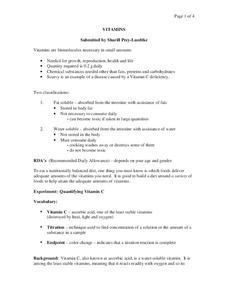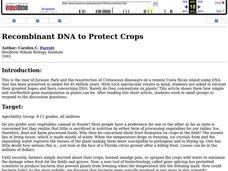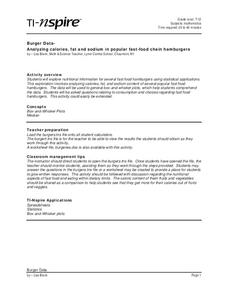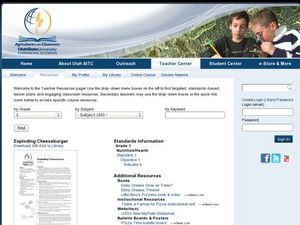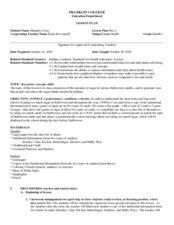Curated OER
An Egg is Quiet
Students discover information about animal eggs by reading the book, An Egg is Quiet. In this animal science lesson, students research different animals to find out what their eggs look like. Students use a provided chart to guide...
Curated OER
Philanthropy, Volunteering And Service: the Historical Connections Lesson 2: Hunger Hurts
Students investigate the effects of hunger on a personal and community level. They examine how philanthropy can help alleviate hunger issues in the world and in their own community. They look at the available services using Internet...
Curated OER
Sea Otters--Funny Mammals of the Sea
In this sea otters worksheet, students read a 2 page article on sea otters, define 12 vocabulary words from the article and answer 7 comprehension questions in complete sentences.
Curated OER
Insects!
Students explore the diet of insects. In this "insects" biology lesson, students take a nature walk and collect various natural materials they think may be eaten by insects. Students sort and classify these materials into three diet...
Curated OER
What Plants Need in Order to Survive and Grow: Air
Students conduct an experiment to determine whether plants need air in order to survive and grow. They discuss natural resources, analyze slides, and observe and record data from the experiment.
Curated OER
Fit for Our Future
Learners understand the importance of physical fitness as part of a healthy lifestyle. In this health lesson students create a display and presentation about what they learned.
Curated OER
What's My BMI?
Students construct the Metric Pyramid from the handout. They use the Metric Pyramid to convert from standard to metric measure and vice versa. They compute their own Body Mass Index.
Curated OER
Searching for Information
In this computer worksheet, students use ViewPoint's forward and backward arrows, and the search tool to locate information given about minerals and vitamins. They load the Vitamins datafile and use the search tool to respond to five...
Curated OER
High Five Burger
Fifth graders investigate agricultural sources. In this agricultural instructional activity, 5th graders read the book Have a Hamburger and See the U.S.A. and record each component of a hamburger. Students use a map of the U.S.A. to...
Curated OER
Bread in a Bag
Students explore wheat. In this bread making lesson, students make their own loaf of bread and discover the history behind wheat. They work in pairs to follow step-by-step instructions for making the bread. This lesson includes a...
Curated OER
Inside the Egg, Hatching Chickens
Students explore how an egg becomes fertilized. In this biology instructional activity, students "candle" a variety of eggs in order to determine which ones have been fertilized and which ones haven't. Student use paper plates to create...
Curated OER
What Plants Need in Order to Survive and Grow: Light
Students conduct an experiment to evaluate whether plants need light to survive and grow. They observe and gather data about plant responses to different growth regimes, analyze the data, and make conclusions about basic plant needs.
Curated OER
What Plants Need in Order to Survive and Grow: Soil
Students conduct an experiment to evaluate whether plants need soil to survive and grow. They plant two seeds, one with soil and one without, make predictions, and record and analyze the seed germination results on a worksheet.
Curated OER
Vitamins
Students determine the amount of vitamin C present in 3 samples of juice stored in various light conditions. In this vitamin lesson plan, students investigate the amount of vitamin C present in juice exposed to different quantities of...
Curated OER
Vermicomposting
First graders investigate composting. In this biology lesson plan, 1st graders identify ways to use garbage as fertilizer. Students examine soil and compost matter as well as the role of worms in the dirt.
Curated OER
Loco for Cocoa
Third graders research the history of cocoa. In this cocoa lesson, 3rd graders investigate how the cocoa bean has been traded from one country to another. Students create a timeline and map to track the history of the cocoa bean.
Curated OER
Recombinant DNA to Protect Crops
Students are asked to recount their greatest hopes and fears concerning DNA. One article states how worthwhile gene manipulation in plants can be. Classroom discussions arise after reading one article on this issue.
Curated OER
Human Population Growth
In this human population growth worksheet, learners create a graph of human population growth and predict future growth using the data given in a chart. Students identify factors that affect population growth.
Curated OER
Box-and-Whisker Plots
Students explore nutritional information for several fast food hamburgers using statistical applications. In this statistics instructional activity, students analyze calories, fat, and sodium content of various fast food restaurants....
Curated OER
Thanksgiving Feast (Read the Charts)
Learners practice reading charts about foods country of origin. They interpret information and answer questions related to charts. They discover how food production adds to the economy.
Curated OER
Buckets of Bucks for World Hunger
Students participate in a nonprofit organization activity for hunger outreach problems. In this service project lesson plan, students practice counting coins, complete a service project for a hunger outreach, discuss nutrition and...
Curated OER
Exploding Cheeseburgers
Young scholars identify the components of a healthy diet. In this nutrition lesson, students discuss the parts of a cheeseburger and identify the food groups the cheeseburger is a part of. Young scholars discuss how carbohydrates and...
Curated OER
Halloween Candy/ Sugar Content
Fourth graders examine the amount of sugar contained in Halloween candy by looking at nutritional labels from candy bars. They figure out ways to encourage people to reduce the amount of sugar they eat at this holiday. They look at the...
Curated OER
Determination of the Physical Properties of Dietary Fibers
In this dietary fibers worksheet, students compare and contrast the properties of different fibers: cellulose, hemicellulose, pectin, guar, agar, and xanthan gum. This worksheet has 5 short answer questions.






